"Bran" - "machine gun for gentlemen"
"Bran" Mk I with a folded cocking handle.
That is, the weapon is certainly interesting and fully deserves the most detailed story about yourself.
So began story "Bran" long before, in fact, his appearance, during the First World War, where the British used easel machine guns "Vikkers" Mk I and Lewis MXXX light machine guns of the year. True, they didn’t like the BAR M1915 A1918 automatic rifle, which fired British .2 cartridges (303 x 7,7 R), and then in the 56 year, they were preoccupied with creating a committee that had to test various samples of foreign light machine guns and choose the best from them.
In the competition participated: two Browning machine guns - the American BAR M1918 A2 and the Belgian FN M1922, then the Danish "Madsen" in the British version, under the British ammunition; French “Hotchkiss”, a modification of the LMG Mle 1909 - Mle 1924, used by the British cavalry during the war years; American Lewis, (type D) 1915 modification of the year; and the “native” Bidmore - Farhar Mk I. They fired a lot and for a long time, then in the 1924-1930. held four more competitions, established the first prize for the winner in the amount of £ 3000, but none of the machine guns could not stand the test.
During the 1927 test of the year, the Czech machine gun ZB-26 by Václav Cholek (1886-1954) also hit them. The latter, being self-taught, like Browning or Degtyarev, managed, however, to create a completely competitive model, which had already been adopted for use in Czechoslovakia and was manufactured at the Brno factory. However, the Holek machine gun was designed under the German cartridge for the "Mauser" of the 7,92-mm caliber without rim, and the British needed a weapon for the cartridges with the 7,71-mm caliber rifle used in the Lee-Enfield rifle.
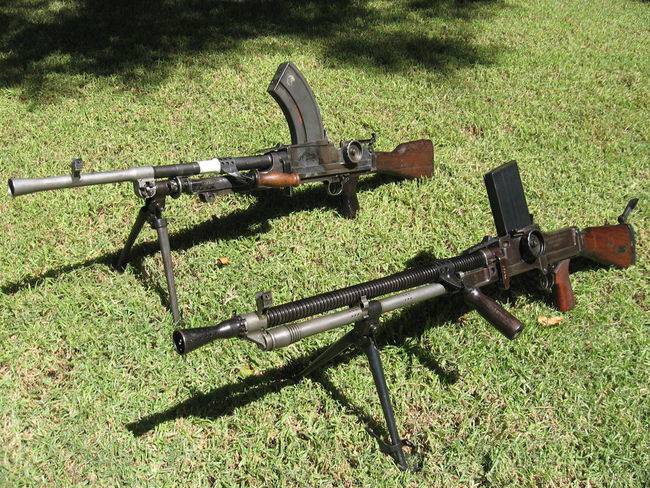
"Bran" and next to him his Czechoslovak predecessor ZB vz.26.
October 29 1930, the next competition began. This time the French machine gun Darna was tested, which, however, was not successful due to delays, the Hungarian Kiray-Ende and the British Vickers-Berthier Mk I. The Czech machine gun was also tested and showed good results. By this time, China had acquired a license for its production, so that this weapon was already at war. Each year a sample appeared that was somehow different from the previous one, so the improvement of the basic model went "step by step", that is, "step by step".
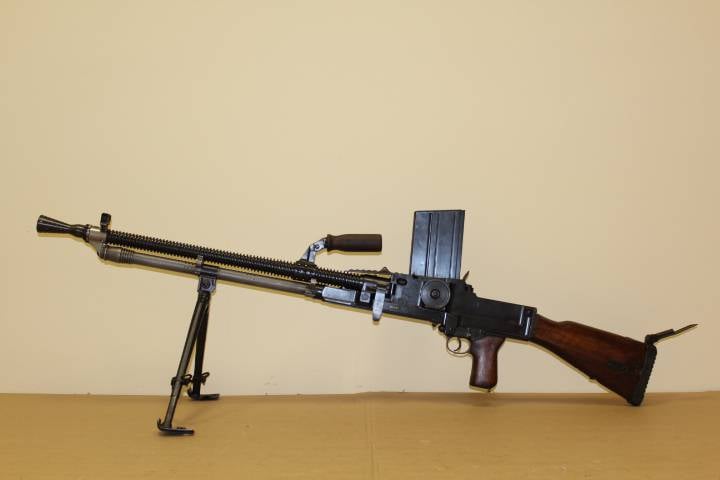
The machine gun ZB 30 - MG 26 (t).
In June 1931, the model ZB 30 received the English name GBS 30 (United Kingdom - Sbroevka), took part in the test along with the French machine gun of Darn and the English "Vikkers-Berthier" Mk II. Fire was fired at targets from 500 to 2500 yards at the Hite range, weapons survivability after 10000 shots was determined at the Royal Small Arms Factory (RSAF) at Enfield, in Midllsex. In “Protocol No. 1188 "about the GBS 30 reported" ... the GBS machine gun is an excellent specimen made of good materials and can be recommended for use. "
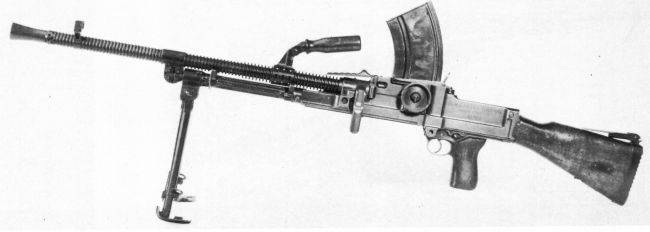
Czechoslovak experienced machine gun ZGB-30 caliber .303.
However, only the model ZB vz.33 fully satisfied the British military. On a sample modernized by Anton Marek, Emanuel and Wenceslaus Cholekami, the flue pipe length was changed, the barrel was made without fins (on the Czech sample the fins went to the trunk flue pipe), and, of course, the shape of the store was changed. In Czech it was straight, but in English it turned out to be strongly curved under the British .303 ammunition with a rim. The gas regulator was also installed on four positions, which allows to achieve reliable operation even if the mechanism is soiled with carbon deposits. However, he was once again tested with the domestic VB Mk II in August 1934 of the year, and ultimately the “Czech” beat the “Englishman”, revealing the complete superiority of Czechoslovak weapons. This was followed by army tests in Her Majesty’s own Queen 4 Hussars, and the royal hussars also spoke for the machine gun of a foreigner, although, as you know, foreigners in England at that time were not very fond of.
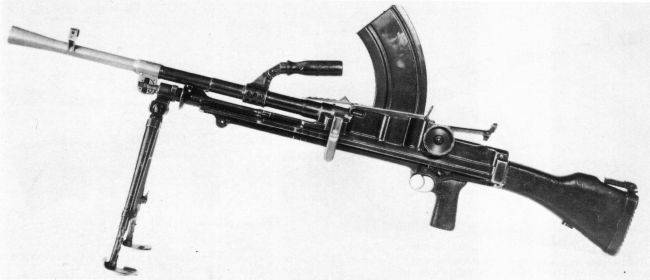
Czechoslovak experienced machine gun ZGB-33 caliber .303.
A total of 33500 shots were made on each test trunk. The tests began in January, and in early February 1934 of the year ended. Theoretically, the machine gun was calculated on 70000 shots. The machine gun was called "Bran" - abbreviated from Brno-Enfield, but its first model, which received the Mark I, saw the light of only 3 of September 1937 of the year. Almost three years, the English engineers took the development and running production technologies. The fact is that, as it turned out, making such a good weapon is not very easy. It was necessary to perform 226 operations only for the manufacture of the receiver (!), All of which were carried out on ... milling machines! That is, initially it was necessary to take a 10-kilogram steel bar, and then skip it through several different machines and eventually remove 8 kilograms of chips from it! The part itself, which went to the assembly, weighed only 2 kg! To produce a shutter, 270 operations had to be performed, and in both cases 550 measurements had to be carried out, and tolerances reached the 0,0005 inch (0,0127 mm). By the end of 1937, 42 was manufactured by Bran, and since May of next year, the production volume reached 200 units per week.
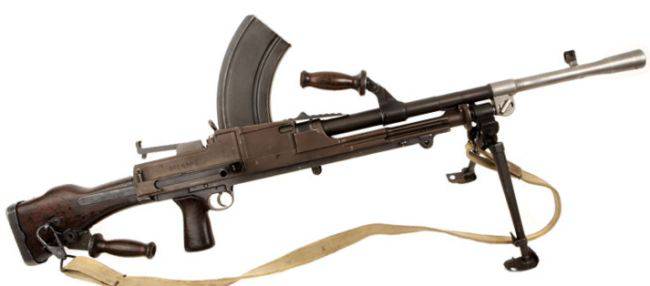
Manual machine gun "Bran" Mk I.
4 August 1938 "Bran" Mk I was officially adopted by the British army. Production growth reached 300 units per week. First of all, the new machine gun entered the motorized units and looked at it "almost like a relic," but even there only senior non-commissioned officers had the right to treat it first. However, by the 1940, the plant produced their 30000 units, which allowed them to feed the troops and train not only non-commissioned officers, but private soldiers to work with them. True, it turned out that the store, loaded 30-th ammunition, often jammed. But if you load 28 or 29 cartridges into it, then this trouble could be avoided.
Now every British infantry unit consisting of 10 people got their own "bran". The calculation consisted of two infantrymen: №1 - machine gunner-shooter, №2 - assistant (carrier of ammunition). Each compartment relied on 25 equipped stores, and on the form of the sample 1937, specially provided pockets for carrying them. The machine gun turned out to be convenient and “soldier-proof”; in addition, it was ideally suited for conducting dagger fire in defense, and in attack it was possible to shoot both from the hip and from the shoulder. The rate of 500 fires per minute allowed it to be easily controlled, and the overheated barrel could be easily replaced with a new one, for every machine gun they were supposed to be six pieces!
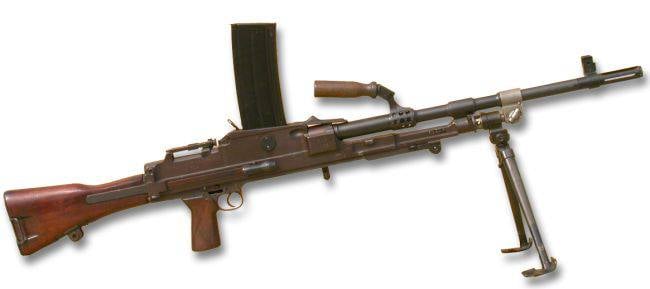
Manual machine gun "Bran" L4A4 chambered for caliber 7,62x51 NATO.
By the time 3 of September 1939 of the year Britain entered the Second World War, the production of "brands" had reached the level of 400 units per week. 90% machine guns were sent to France, where they were lost. After the tragedy of Dunkirk, only 2,300 units remained in the army. But the Germans adopted them under the name "Leichte MG-138 (e)". The threat of being left without a light machine gun was so great that urgent measures were taken to increase the output. A new model of the Mk II was urgently developed, in which only the principle of operation remained from the old one. The complex drum scope was removed, the additional handle for the left hand under the butt was removed, the bipods were also simplified. Then came samples Mk III and Mk IV. The first one with a barrel shortened to 565 mm (its weight was 8,6 kg), the second with a modified butt. In Canada, produced a machine gun for the Chinese chambered for 7,92-mm and with a direct shop. At the same time, the Mk I model also continued to be produced even in the 1944 year, so that several types of machine guns were exploited in the army. During the war years, about 300000 machine guns of all these types were fired. In Taiwan, in 1952, a new version was launched - the M 41 for American cartridges. 30-06 (7,62 x 63).
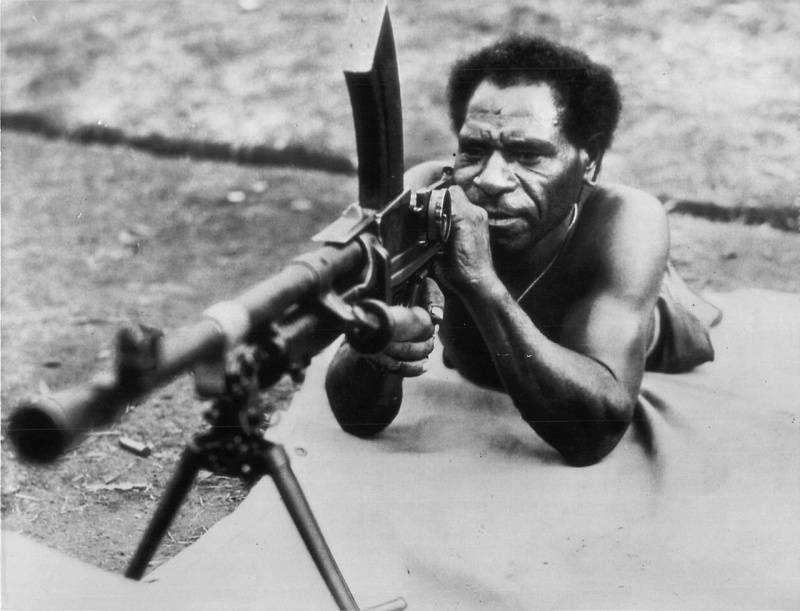
During the years of the Second World War, even the natives of New Guinea were shooting from the “brands”!
The adoption of the American cartridge .1953W (308x762) in 51 as the main rifle cartridge for NATO led to the fact that the British “branes” of the .303 caliber had to be redone for this new caliber. This is how the "bran" of the Mk III, converted to this standard NATO cartridge, appeared. His barrel is chrome-plated, which increased the survivability of the weapon, the store is straight, there is no conical flame arrester It is called "L4-A4". It was used by the Royal Marine Corps in the Falklands and during the Gulf War. So it can be attributed to the "long-livers".
(To be continued)
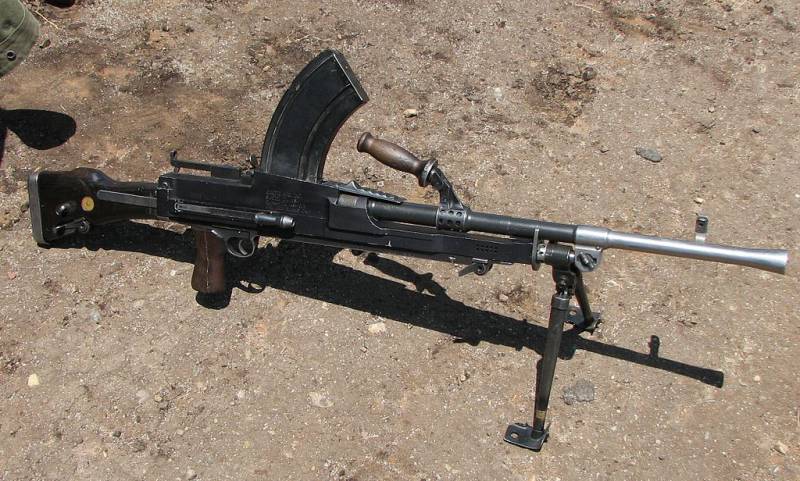
Information